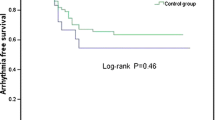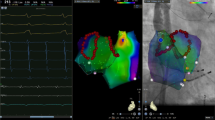Abstract
Purpose
This study aimed to evaluate efficacy, safety, and long-term outcome of radiofrequency catheter ablation (RFCA) for atrial tachyarrhythmia (ATa) in patients with atrial septal defect (ASD).
Methods
Seventy-five ASD patients with ATa (52% atrial fibrillation, AF) were enrolled. Electrophysiological study and RFCA were performed, with endpoints of index and multiple procedures as follows: (a) atrial tachycardia/atrial flutter (AT/AFL), absence of inducibility of any atrial arrhythmia and (b) AF, circumferential pulmonary vein ablation (CPVA, paroxysmal AF), bidirectional block of lines, and disappearance of complex fractionated atrial electrograms (persistent and long-standing persistent (LSP)-AF).
Results
Cumulative success rate at 1-year follow-up was 79.9% and dropped to 59.0% at a median follow-up of 63 months (range, 14–114 months) for multiple procedures (mean 1.6 ± 0.7 [1–3]). Freedom from ATa after multiple procedures was achieved in 75% patients with AT/AFL and 43.6% patients with AF (P = 0.006 for comparison). In multivariate analysis, older age at ASD correction (HR, 1.033 [95% CI, 1.008–1.059]; P = 0.01), ASD diameter before correction (HR, 1.054 [95% CI, 1.006–1.105]; P = 0.027), and first-diagnosed ATa type (AF; HR, 2.25 [95% CI, 1.03–4.92]; P = 0.042) were significant independent predictors of ATa recurrence. Patients with more risk factors had higher risk of ATa recurrence.
Conclusions
The long-term outcome of RFCA for ATa outcome was favorable for AT/AFL while mediocre for AF. ATa recurrence was more common in patients with older age at ASD correction, larger ASD diameter before correction, and first-diagnosed AF. Patients with more risk factors had higher ATa recurrence risk.



Similar content being viewed by others
References
Marelli AJ, Mackie AS, Ionescu-Ittu R, Rahme E, Pilote L. Congenital heart disease in the general population: changing prevalence and age distribution. Circulation. 2007;115(2):163–72. CIRCULATIONAHA.106.627224 [pii]. https://doi.org/10.1161/CIRCULATIONAHA.106.627224.
Bouchardy J, Therrien J, Pilote L, Ionescu-Ittu R, Martucci G, Bottega N, et al. Atrial arrhythmias in adults with congenital heart disease. Circulation. 2009;120(17):1679–86. https://doi.org/10.1161/CIRCULATIONAHA.109.866319 CIRCULATIONAHA.109.866319 [pii].
Wells R, Khairy P, Harris L, Anderson CC, Balaji S. Dofetilide for atrial arrhythmias in congenital heart disease: a multicenter study. Pacing Clin Electrophysiol. 2009;32(10):1313–8. https://doi.org/10.1111/j.1540-8159.2009.02479.x PACE2479 [pii].
Baumgartner H, Bonhoeffer P, De Groot NM, de Haan F, Deanfield JE, Galie N, et al. ESC guidelines for the management of grown-up congenital heart disease (new version 2010). Eur Heart J. 2010;31(23):2915–57. https://doi.org/10.1093/eurheartj/ehq249 ehq249 [pii].
Page RL, Joglar JA, Caldwell MA, Calkins H, Conti JB, Deal BJ, et al. 2015 ACC/AHA/HRS guideline for the Management of Adult Patients with Supraventricular Tachycardia: a report of the American College of Cardiology/American Heart Association task force on clinical practice guidelines and the Heart Rhythm Society. J Am Coll Cardiol. 2016;67(13):e27–e115. S0735-1097(15)05840-4 [pii]. https://doi.org/10.1016/j.jacc.2015.08.856.
Zhao L, Xu K, Jiang W, Zhou L, Wang Y, Zhang X, et al. Long-term outcomes of catheter ablation of atrial fibrillation in dilated cardiomyopathy. Int J Cardiol. 2015;190:227–32. https://doi.org/10.1016/j.ijcard.2015.04.186 S0167-5273(15)00919-5 [pii].
Kirchhof P, Benussi S, Kotecha D, Ahlsson A, Atar D, Casadei B, et al. 2016 ESC guidelines for the management of atrial fibrillation developed in collaboration with EACTS. Europace. 2016;18(11):1609–78. https://doi.org/10.1093/europace/euw295.
Santangeli P, Di Biase L, Burkhardt JD, Horton R, Sanchez J, Bailey S, et al. Transseptal access and atrial fibrillation ablation guided by intracardiac echocardiography in patients with atrial septal closure devices. Heart Rhythm. 2011;8(11):1669–75. https://doi.org/10.1016/j.hrthm.2011.06.023 S1547-5271(11)00711-9 [pii].
Mandalenakis Z, Rosengren A, Lappas G, Eriksson P, Gilljam T, Hansson PO, et al. Atrial fibrillation burden in young patients with congenital heart disease. Circulation. 2017. CIRCULATIONAHA.117.029590 [pii]. https://doi.org/10.1161/CIRCULATIONAHA.117.029590.
Trojnarska O, Grajek S, Kramer L, Gwizdala A. Risk factors of supraventricular arrhythmia in adults with congenital heart disease. Cardiol J. 2009;16(3):218–26.
Nie JG, Dong JZ, Salim M, Li SN, Wu XY, Chen YW, et al. Catheter ablation of atrial fibrillation in patients with atrial septal defect: long-term follow-up results. J Interv Card Electrophysiol. 2015;42(1):43–9. https://doi.org/10.1007/s10840-014-9958-z.
Geva T, Martins JD, Wald RM. Atrial septal defects. Lancet. 2014;383(9932):1921–32. https://doi.org/10.1016/S0140-6736(13)62145-5 S0140-6736(13)62145-5 [pii].
Fuse S, Tomita H, Hatakeyama K, Kubo N, Abe N. Effect of size of a secundum atrial septal defect on shunt volume. Am J Cardiol. 2001;88(12):1447–50 A9. S0002914901021348 [pii].
Suchon E, Tracz W, Podolec P, Sadowski J. Atrial septal defect in adults: echocardiography and cardiopulmonary exercise capacity associated with hemodynamics before and after surgical closure. Interact Cardiovasc Thorac Surg. 2005;4(5):488–92. https://doi.org/10.1510/icvts.2004.101451.
Thilen M, Christersson C, Dellborg M, Mattsson E, Trzebiatowska-Krzynska A, Thilen U. Catheter closure of atrial septal defect in the elderly (>/=65years). A worthwhile procedure. Int J Cardiol. 2016;218:25–30. S0167-5273(16)30918-4 [pii]. https://doi.org/10.1016/j.ijcard.2016.05.024.
Roos-Hesselink JW, Meijboom FJ, Spitaels SE, van Domburg R, van Rijen EH, Utens EM, et al. Excellent survival and low incidence of arrhythmias, stroke and heart failure long-term after surgical ASD closure at young age. A prospective follow-up study of 21-33 years. Eur Heart J. 2003;24(2):190–7 S0195668X02003834 [pii].
Avila P, Oliver JM, Gallego P, Gonzalez-Garcia A, Rodriguez-Puras MJ, Cambronero E, et al. Natural history and clinical predictors of atrial tachycardia in adults with congenital heart disease. Circ Arrhythm Electrophysiol. 2017;10(9). https://doi.org/10.1161/CIRCEP.117.005396 CIRCEP.117.005396 [pii].
Scaglione M, Caponi D, Ebrille E, Di Donna P, Di Clemente F, Battaglia A, et al. Very long-term results of electroanatomic-guided radiofrequency ablation of atrial arrhythmias in patients with surgically corrected atrial septal defect. Europace. 2014;16(12):1800–7. https://doi.org/10.1093/europace/euu076euu076 [pii].
Giardini A, Donti A, Sciarra F, Bronzetti G, Mariucci E, Picchio FM. Long-term incidence of atrial fibrillation and flutter after transcatheter atrial septal defect closure in adults. Int J Cardiol. 2009;134(1):47–51. https://doi.org/10.1016/j.ijcard.2008.02.003 S0167-5273(08)00141-1 [pii].
Patterson E, Jackman WM, Beckman KJ, Lazzara R, Lockwood D, Scherlag BJ, et al. Spontaneous pulmonary vein firing in man: relationship to tachycardia-pause early afterdepolarizations and triggered arrhythmia in canine pulmonary veins in vitro. J Cardiovasc Electrophysiol. 2007;18(10):1067–75. JCE909 [pii]. https://doi.org/10.1111/j.1540-8167.2007.00909.x.
Cox JL, Canavan TE, Schuessler RB, Cain ME, Lindsay BD, Stone C, et al. The surgical treatment of atrial fibrillation. II. Intraoperative electrophysiologic mapping and description of the electrophysiologic basis of atrial flutter and atrial fibrillation. J Thorac Cardiovasc Surg. 1991;101(3):406–26.
Haissaguerre M, Hocini M, Denis A, Shah AJ, Komatsu Y, Yamashita S, et al. Driver domains in persistent atrial fibrillation. Circulation. 2014;130(7):530–8. https://doi.org/10.1161/CIRCULATIONAHA.113.005421 CIRCULATIONAHA.113.005421 [pii].
Author information
Authors and Affiliations
Corresponding author
Ethics declarations
Informed consent was obtained from all individual participants included in the study, and the study conformed to the ethical guidelines of the Declaration of Helsinki and was approved by institutional ethics committee.
Conflict of interest
The authors declare that they have no conflict of interest.
Additional information
Cheng Wang is co-first author
Xin Pan is co-correspondence
Rights and permissions
About this article
Cite this article
Wang, H., Wang, C., Chen, J. et al. Long-term outcome of catheter ablation for atrial tachyarrhythmias in patients with atrial septal defect. J Interv Card Electrophysiol 54, 217–224 (2019). https://doi.org/10.1007/s10840-018-0505-1
Received:
Accepted:
Published:
Issue Date:
DOI: https://doi.org/10.1007/s10840-018-0505-1




